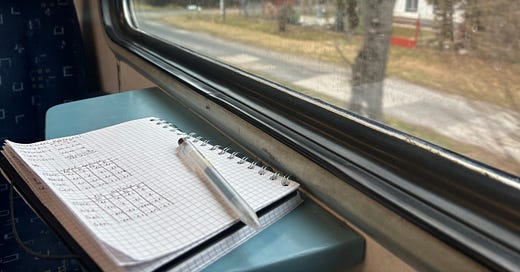KESZTHELY, Hungary — During our sophomore year of college, Jeremy and I took a Greyhound bus from Chicago to Madison, Wisconsin. We were on the way to the University of Wisconsin to watch Northwestern play football.
We left late on a Friday evening. I remember sitting on the hushed, darkened bus as we drove north through the Chicago suburbs and into Wisconsin farmland. I turned to Jeremy and said, “Isn’t traveling like this exciting? I feel like we could go anywhere.”
My readers who know Jeremy won’t be surprised to learn he did not share the sentiment.
True, maybe I was overstating it a bit. The three-hour trip from Chicago to Madison isn’t exactly the adventure of a lifetime. But for some reason, that night, it felt thrilling. Like I could ride to the end of the line and get on another bus and another, until I found myself thousands of miles from where I began.
Why exactly I fantasize about such things is anyone’s guess, but I suspect it was something about that instinct that brought me to Dresden. (I think it’s also part of why Jeremy and I aren’t together anymore.)
I was reminded of that conversation last week, as I sat looking out the window of a České Dráhy train to Prague.
Traveling by train that morning didn’t exactly feel charged with possibility. But as I looked out at the Elbe winding by outside my window, I thought of the hundreds of miles of train tracks that stretched between my final destination and me. I imagined the long journey ahead of me like the dotted line on a map in an Indiana Jones movie.
It was the first leg of my trip to Keszthely, Hungary, a town on the western shore of Lake Balaton. Getting there from Dresden would take me a total of 12 hours, which I split over two days. First, from Dresden to Budapest via Prague, then the following morning from Budapest on to Keszthely.
In Budapest, I paid €15 for a bed in something that billed itself as a “zen hostel,” which frankly, I couldn’t get out of fast enough. I woke up early on Saturday to catch my train, and I arrived in Keszthely around 11 a.m. I was probably the only American on the Balaton Express that morning.
(More on what exactly I’m doing in Keszthely in my next dispatch.)
To be clear, I wasn’t traveling by train because of my romantic associations with land-bound transportation. It was somehow neither cheaper nor faster to fly — from Dresden, Berlin, Prague or anywhere else. So instead, I paid €40 for the train from Dresden to Budapest, plus about €4 for the train from Budapest to Keszthely.
The drive time between Dresden and Keszthely is only seven and a half hours. If I’d been trying to go a similar distance in the U.S., I probably would have driven.
For most of my life, I’ve traveled basically everywhere by car or plane. Jeremy and I were only taking the bus to Madison in the first place because neither of us had a car. In the U.S., traveling by bus or train often feels more like a charming anachronism than a real way to get places.
Of course, Greyhound buses and AmTrak trains exist, but they’re rarely the most efficient, comfortable or affordable way to get anywhere.
Traveling long distances by bus or train, which once felt novel and exciting, is now just a regular part of my life. It’s how I get most places — I make the trip from Dresden to Berlin and back by train about once a month.
So far, my longest train journeys (aside from the most recent one) have been nine hours from Dresden to Krakow and eight hours across three regional trains from Dresden to Salzburg. Because I only used regional trains, that entire journey was covered by my Deutschland Ticket, and I didn’t have to pay anything additional.
My tuition at TU Dresden (a whole €288.10 per semester) includes a Deutschland Ticket transit pass, which entitles me to travel at no additional cost on local and regional trains anywhere in Germany. (For reference, paying for a Deutschland Ticket myself would cost €58 per month, or €348 for the six-month semester.)
Sometimes the cheap option has an allure I just can’t pass up, so I find myself cobbling together some strange itineraries.
One of the worst decisions I’ve made for a cheap trip was booking a train itinerary from Munich to Dresden with a four-hour connection in Leipzig from midnight to 4 a.m. After sitting in the Leipzig Hauptbahnhof for three hours, I gave up and took the first FlixBus of the day to Dresden.
I basically never travel by plane these days. In large part, that’s because it’s almost impossible to get anywhere quickly or cheaply from the airport in Dresden, which serves about 10 destinations. To get most places, you have to connect through Frankfurt, Munich or Zurich.
Back in October, I went to Brussels for a conference, which covered my airfare from of Dresden. According to the booking confirmation the trip organizer forwarded me, the roundtrip itinerary cost more than $1,000.
There’s also a level of spontaneity with train and bus travel that can’t exist with air travel. To fly somewhere requires too much forethought and jumping through too many hoops. I have to know in advance where I’m starting, where I’m going and usually when I’m coming back. On top of that, I have to get to the airport an hour and a half early and go through security.
When I travel by bus or train, I rarely book my return trip ahead of time. I haven’t even booked my passage from Keszthely back to Dresden yet.
But I’ve learned that waiting to book a train ticket isn’t always the best move. When I was in Poland in October, I didn’t try to book my journey from Oświęcim to Wrocław until I arrived at the station that morning. That was apparently too late, and the Polish Railways website wouldn’t let me buy the ticket for the first leg of the journey.
But I wasn’t to be deterred, and the next train wouldn’t be for a few hours. So I boarded anyway, and I hid in the bathroom for the whole half-hour trip to Katowice. It was a particularly humiliating moment, considering I would’ve happily paid the train fare, which amounted to no more than a few euros.
When I’m not hiding out in the bathroom, I like taking land-bound transportation because I feel more observant. Instead of entering the fourth dimension of air travel, I stay rooted in the earthly realm. I see landscapes I wouldn’t otherwise, and I pay more attention to the people around me. But maybe I’m just scanning the crowd, hoping to meet some handsome stranger, Before Sunrise-style.
That’s not to say every train or bus trip I’ve taken has come with stunning scenery (or handsome strangers).
My journey from Dresden to Krakow took me through some of the most topographically uninspired places I’ve ever seen. And that’s coming from someone who once took a road trip from Boise, Idaho, to Griffin, Georgia.
But sometimes what I see out the window makes the journey worth it. When I’m on the train from Dresden to Berlin and the soft-focus afternoon light hits the fields just right, the view looks like a Caspar David Friedrich painting.
One evening last November, I was taking a RegioJet bus from Prague to Dresden. As we drove north, we entered a thick fog that blotted out what had until then been a clear, sunny day. It obscured the trees and houses that dotted the Czech farmland outside my window, plunging us into a premature twilight.
But as soon as the sun hit the horizon, it illuminated the fog seemingly from within, washing the fields in a warm pink glow. And for a few minutes, the light of the sunset felt like something you could reach out and touch. ▣





